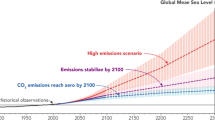Abstract
The potential impacts of sea level rise (SLR) on 95% of the land areas of the Florida Keys were estimated through analysis of a digital elevation model (DEM) derived from airborne light detection and ranging (LiDAR) measurements in a geographic information system. The topographic detail of the LiDAR DEM allowed projections of land, population, and property inundation in 0.15 m increments across a broad range of SLR scenarios for the next century. The results showed that a 0.6 m SLR by 2100 would inundate about 70% of the total land surface, but smaller percentages of the population (17%) and real property (12%). A 1.5 m rise in sea level during the same period would inundate 91% of the land surface, 71% of the population and 68% of property in the study area. Comparison of inundation dynamics indicates that the Lower Florida Keys are more susceptible to SLR than the Upper Florida Keys. The inundation dynamics exhibit non-linear behavior and demonstrate tipping points in inundation processes beyond which the inundation of land, population, and property speeds up. Acceleration of SLR will amplify the non-linear inundation, causing tipping points to be reached sooner.
Similar content being viewed by others
References
3001 Inc. (2008a) LiDAR Processing Report: Block 1. Slidell, Louisiana, p 33
3001 Inc. (2008b) Vertical Accuracy Report: Block 1. Slidell, Louisiana, p 81
Bamber JL, Riva RE, Vermeersen BL, LeBrocq AM (2009) Reassessment of the potential sea-level rise from a collapse of the west antarctic ice sheet. Science 324:901–903
Church JA, White NJ (2006) A 20th century acceleration in global sea level rise. Geophys Res Lett 33:1–4
Davis JC (2002) Statistics and data analysis in geology. Wiley, Hoboken, p 56
Douglas BC (2001) Sea level change in the era of the recording tide gauge. In: Douglas BC, Kearney MS, Leatherman SP (eds) Sea level rise: history and consequences. Academic, San Diego, pp 37–64
Gibson PJ, Boyer JN, Smith NP (2008) Nutrient mass flux between Florida Bay and the Florida Keys National Marine Sanctuary. Estuaries Coasts 31:21–32
Halley RB, Vacher HL, Shinn EA (1997) Geology and hydrogeology of the Florida Keys. In: Vacher HL, Quinn TM (eds) Geology and hydrology of carbonate islands. Developments in sedimentology 54. Elsevier, Amsterdam
Hansen JE (2007) Scientific reticence and sea level rise. Environ Res Lett 2:1–6
Harrington DJ, Walton DT (2007) Climate change in coastal areas in Florida: sea level rise estimation and economic analysis to year 2008. Florida State University, Tallahassee, p 87
He R, Weisberg RH (2002) Tides on the west Florida Shelf. J Phys Oceanogr 32:3455–3473
IPCC (2007) Climate change 2007: the physical basis—summary for policymakers. IPCC, Geneva
Leatherman SP (1984) Coastal geomorphic responses to sea level rise in and around Galveston, Texas. In: Barth MC, Titus JG (eds) Greenhouse effect and sea level rise: a challenge for this generation. Van Nostrand Reinhold, New York, pp 151–178
Meehl GA, Stocker TA, Collins WD, Friedlingstein P, Gaye AT, Gregory JM, Kitoh A, Knutti R, Murphy JM, Noda A, Raper SCB, Watterson IG, Weaver AJ, Zhao Z-C (2007) Global climate projections, climate change 2007: the physical science basis. Contribution of Working Group I to the fourth assessment report of the Intergovernmental Panel on Climate Change. Cambridge University Press, Cambridge
Nature Conservancy (2009) Initial estimates of the ecological and economic consequences of sea level rise on the Florida Keys through the year 2100. Nature Conservancy, Arlington
Nicholls RJ (2004) Coastal flooding and wetland loss in the 21st century: changes under the SRES climate and socio-economic scenarios. Glob Environ Change 14:69–86
Nicholls RJ, Leatherman SP, Dennis KC, Volonte CR (1995) Impacts and responses to sea-level rise: qualitative and quantitative assessments. J Coast Res 14:26–43 (special issue)
Peters A, MacDonald H (2004) Unlocking the census with GIS. ESRI, Redlands, p 309
Pfeffer WT, Harper JT, O’Neel S (2008) Kinematic constraints on glacier contributions to 21st century sea-level rise. Science 321:1340–1343
Rahmstorf S (2007) A semi-empirical approach to projecting future sea-level rise. Science 315:368–370
Ross MS, O’Brien JJ, Flynn LJ (1992) Ecological site classification of the Florida Keys. Biotropica 24:488–502
Schneider SH, Chen RS (1980) Carbon dioxide warming and coastline flooding: physical factors and climatic impact. Annu Rev Energy 5:107–140
Sella GF, Stein S, Dixon TH, Craymer M, James TS, Mazzotti S, Dokka RK (2007) Observation of glacial isostatic adjustment in “stable” North America with GPS. Geophys Res Lett 34:L02306–L02307
Titus JG, Richman C (2001) Maps of lands vulnerable to sea level rise: modeled elevations along the U.S. Atlantic and Gulf coasts. Climate Res 18:205–228
Titus JG, Wang J (2008) Maps of lands close to sea level along the middle Atlantic Coast of the United States: an elevation data set to use while waiting for LIDAR. In: Titus JG, Strange EM (eds) Background documents supporting climate change science program synthesis and assessment product 4.1: coastal elevations and sensitivity to sea level rise. Environmental Protection Agency, Washington
Vermeer M, Rahmstorf S (2009) Global sea level linked to global temperature. Proc Natl Acad Sci 106:21527–21532
Zhang K (2010) Analysis of non-linear inundation from sea-level rise using LIDAR data: a case study for South Florida. Clim Change. doi:10.1007/s10584-010-9987-2
Zhang K, Douglas BC, Leatherman SP (2004) Global warming and long-term sandy beach erosion. Clim Change 64:41–58
Author information
Authors and Affiliations
Corresponding author
Rights and permissions
About this article
Cite this article
Zhang, K., Dittmar, J., Ross, M. et al. Assessment of sea level rise impacts on human population and real property in the Florida Keys. Climatic Change 107, 129–146 (2011). https://doi.org/10.1007/s10584-011-0080-2
Received:
Accepted:
Published:
Issue Date:
DOI: https://doi.org/10.1007/s10584-011-0080-2




